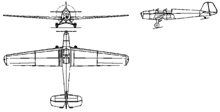Bücker Bü 180
The Bücker Bü 180 Student was a 1930s German two-seat sporting/training aircraft built by Bücker Flugzeugbau.
| Bü 180 Student | |
|---|---|
 | |
| Role | Two-seat sport/training monoplane |
| Manufacturer | Bücker Flugzeugbau |
| First flight | 1937 |
Development
In January 1937 Major Werner Junck, chief of the LC II, the technical wing of the Reichsluftfahrtministerium responsible for the development of new aircraft, informed various minor aircraft manufacturers such as Bücker, Fieseler, Gothaer Waggonfabrik, Flugzeugwerke Halle and Klemm that they would not get any contracts for the development of military aircraft. He therefore advised them to concentrate in the development of a Volksflugzeug or a small twin-engined plane. Following on from the success of the Bü 133 Jungmeister the Bücker company designed the Bü 180, while the other companies produced the Fi 253, the Si 202, the Kl 105 and the Go 150.[1]
It was a low-wing cantilever monoplane that would be later used as a trainer aircraft and named Student. The wing was of wooden construction with a mixture of plywood and fabric covering. The fuselage was a steel tube frame forward and a wooden monocoque aft with a fabric covering. The Student had a fixed tailskid landing gear and was powered by a Walter Mikron II inline engine. The prototype first flew in 1937 and a small number were built for civilian use.
Variants

- Bü 180A
- Production variant with a 50hp Zündapp Z9-092 engine.
- Bü 180B
- Production variant with a 60hp Walter Mikron II engine.
- Bü 180C
- Proposed variant with an 80hp Bücker Bü M700 engine.
Specifications (Bü 180)

Data from Aircraft of the Third Reich and The Encyclopedia of World Aircraft. [2][3]
General characteristics
- Crew: 2
- Length: 7.1 m (23 ft 4 in)
- Wingspan: 11.5 m (37 ft 9 in)
- Height: 1.85 m (6 ft 1 in)
- Wing area: 15 m2 (160 sq ft)
- Empty weight: 295 kg (650 lb)
- Gross weight: 540 kg (1,190 lb)
- Powerplant: 1 × Walter Mikron II inverted 4-cyl. air-cooled in-line piston engine, 45 kW (60 hp)
- Propellers: 2-bladed fixed pitch propeller
Performance
- Maximum speed: 175 km/h (109 mph, 94 kn) at sea level
- Cruise speed: 160 km/h (99 mph, 86 kn)
- Range: 650 km (400 mi, 350 nmi)
- Service ceiling: 4,500 m (14,800 ft)
- Time to altitude: 1,000 m (3,281 ft) in 8 minutes 54 seconds
See also
Related development
Aircraft of comparable role, configuration and era
References
| Wikimedia Commons has media related to Bücker Bü 180. |
Notes
- Luftarchiv - Fieseler Fi 253
- Green, William (2010). Aircraft of the Third Reich (1st ed.). London: Aerospace Publishing Limited. pp. 136–144. ISBN 978-1-900732-06-2.
- Donald 1997, p.218.
Bibliography
- Donald, David (editor). The Encyclopedia of World Aircraft. Leicester, UK:Blitz, 1997. ISBN 1-85605-375-X.
- König, Erwin. Bücker Bü 180 "Student", Bü 182 "Kornett", Bü 134: Drei geniale Flugzeugtypen, die dem Krieg zum Opfer fielen (Flugzeug Profile 36) (in German). D-86669 Stengelheim, Germany: Unitec Medienvertrieb e.K.,
- König, Erwin. Die Bücker-Flugzeuge (The Bücker Aircraft) (bilingual German/English). Martinsried, Germany: Nara Verlag, 1987. ISBN 3-925671-00-5.
- König, Erwin. Die Bückers, Die Geschichte der ehemaligen Bücker-Flugzeugbau-GmbH und ihrer Flugzeuge (in German). (1979)
- Wietstruk, Siegfried. Bücker-Flugzeugbau, Die Geschichte eines Flugzeugwerkes (in German). D-82041 Oberhaching, Germany: Aviatik Verlag, 1999. ISBN 3-925505-28-8.